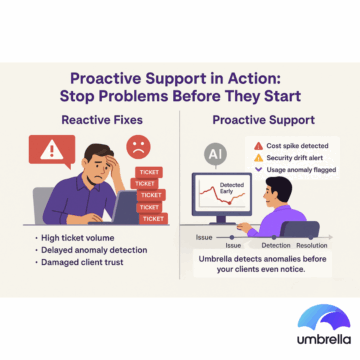This article outlines 7 MSP best practices covering service delivery, FinOps, billing, and customer value, plus how Umbrella’s cloud cost optimization platform helps MSPs scale efficiently
Managed service providers (MSPs) play an increasingly critical role in today’s cloud-first world. As organizations adopt multi-cloud, SaaS, and hybrid environments, they look to MSPs not just for technical support but for guidance on how to run smarter, leaner, and more cost-effective operations.
The MSP market is expected to grow in 2024 and reach nearly $350 billion globally by year-end, with projections exceeding $1 trillion by 2033.
But with great growth comes the pressure to deliver. Clients are demanding clearer ROI, and internal teams need tighter cost control. That’s why today’s most successful MSPs are embracing FinOps: a framework that brings financial accountability to the cloud and helps providers align performance, spend, and value.
This guide outlines 7 essential MSP best practices that span automation, billing, FinOps, and client experience. Whether you’re a seasoned provider or scaling your offerings, these strategies can help you grow sustainably and drive value for your clients.
1. Prioritize Proactive Support Over Reactive Fixes
Proactive support reduces downtime, fosters client trust, and minimizes the need for support tickets, making it a cornerstone of long-term MSP success.
Proactive support reduces downtime, fosters client trust, and minimizes the need for support tickets, and is a cornerstone of long-term MSP success. When MSPs take on larger, more complex client environments, the ability to identify and resolve issues in real time becomes critical for customer success. Whether it’s a cost spike, a configuration drift, or a potential security threat, small problems can quickly escalate into major incidents if they aren’t addressed early.
In FinOps, proactive support flags unusual spend or usage patterns early, preventing budget impact; similarly, in cybersecurity, it detects threats early to avoid breaches or compliance violations. Both areas rely on continuous monitoring, intelligent pattern recognition, and timely responses to minimize risk. That risk could involve financial waste, security vulnerabilities, or a combination of both.
As infrastructure expands and automation increases, the link between financial and operational risk becomes clearer. A spending spike might signal resource waste or a security misconfiguration. Real-time detection helps MSPs respond swiftly, minimize disruption, and ensure value in cost and security management.
Example: Instead of waiting for a client to report a sudden spike in cloud spend or degraded app performance, a proactive MSP would detect the anomaly in real-time and address the root cause before it affects business operations, such as halting a runaway Kubernetes pod or adjusting a misconfigured instance type.
Best practice: Implement AI-driven monitoring and anomaly detection to flag problems early. AI models learn normal usage patterns over time and then analyze incoming data for deviations in spending, usage, or performance. When something looks off, such as a cost spike on a normally stable workload, they trigger alerts immediately, allowing your team to investigate and take action.
Umbrella offers real-time spend anomaly detection, providing MSPs with early warnings when cloud usage or costs spike unexpectedly, before they escalate into customer issues or unplanned expenses.
Benefits of implementing an advanced spend anomaly detection system:
- Lower ticket volume, as fewer issues reach the end user before being resolved.
- Improved SLAs, with faster response times and fewer outages or cost overruns.
- Stronger client relationships, built on trust, reliability, and a reputation for staying ahead of problems, not just reacting to them.
2. Standardize and Automate Workflows
Manual processes leave room for costly mistakes. For MSPs, automation is crucial to delivering consistent and efficient service.
Manual processes leave room for costly mistakes, inconsistent delivery, and slower response times. As MSP workloads grow and expectations for speed and precision rise, standardization is needed for efficient service delivery and to eliminate unnecessary manual tasks. This helps maintain quality for scaling capacity and improving operational efficiency.
Standardization makes every client receive the same level of quality and compliance, no matter the project or team involved. Automation takes it a step further by streamlining deployments, patching, and optimization tasks that would otherwise consume valuable time and introduce risk. Together, these practices create a foundation for MSPs to scale confidently while maintaining service reliability and margin control.
Example: Instead of manually provisioning resources for each new client or applying security patches one by one, MSPs can use Infrastructure as Code (IaC) to deploy environments, configure settings, and apply updates in minutes, all with reusable templates.
Best practice: Use IaC tools like Terraform and Ansible to codify infrastructure and automate deployments. Pair these with platforms like Umbrella Cost to automate repetitive FinOps workflows like detecting idle resources, applying rightsizing recommendations, or generating savings reports for each client on a schedule.
Benefits of automating workflows:
- Reduced human error, since repeatable scripts and automation workflows eliminate the need for manual inputs that often lead to misconfigurations or oversights.
- Faster onboarding and service delivery, as MSPs can stand up client environments, apply best practices, and optimize costs in a fraction of the time.
- Repeatable, scalable processes, allowing teams to handle more clients and more complexity, without burning out technical staff or sacrificing quality.

3. Implement Strong FinOps Practices
To remain profitable and deliver genuine value to clients, MSPs must actively manage cloud spend, optimize resource utilization, and maintain healthy margins, all while accommodating a range of billing structures and client expectations.
To remain profitable and deliver genuine value to clients, MSPs must actively manage cloud spend, optimize resource utilization, and maintain healthy margins. This becomes even more crucial in agile environments, where billing models are subject to frequent changes and margins may need to be adjusted regularly.
Additionally, as AI adoption increases, MSPs must prioritize FinOps practices for GenAI and machine learning workloads. These services often come with usage-based billing tied to GPU consumption, token output, or model inference volume. Without proper visibility, costs can escalate quickly and become difficult to explain to clients.
Example: An MSP might notice one client consistently underutilizes reserved instances while another overspends on on-demand compute. A strong FinOps approach would enable the MSP to reallocate resources, adjust pricing models, and present clients with data-driven opportunities for savings.
Best practice: Adopt a FinOps platform like Umbrella that helps MSPs detect waste, manage shared resources, and optimize both client outcomes and internal margins.
Umbrella FinOps features built for MSPs include:
- FinOps for managed service providers: Tailored capabilities that help MSPs manage cost, usage, and billing across multiple tenants while maintaining control and visibility.
- Chargeback and showback tools: Provide clients with transparency into their usage and costs, eliminating the need for complex spreadsheets or manual tracking.
- Custom billing rules: Enable flexible pricing models, markups, and discount tiers per client, product, or environment.
- Margin tracking across clients and services: Automatically calculate and monitor profit margins in real time, so you can make smarter business decisions and avoid surprises at the end of the month.
- AI workload visibility and attribution: Track GPU usage, monitor model-level spend, and allocate AI costs to the right client, team, or project for accurate reporting and financial accountability.
Benefits of implementing strong FinOps practices:
- Gain full visibility into cost drivers and resource waste across all clients.
- Deliver tailored reports and insights that demonstrate value to customers.
- Enhance profitability by monitoring margins and optimizing spending at scale.
- Improve control over AI-specific infrastructure costs and a more accurate attribution in client-facing environments.
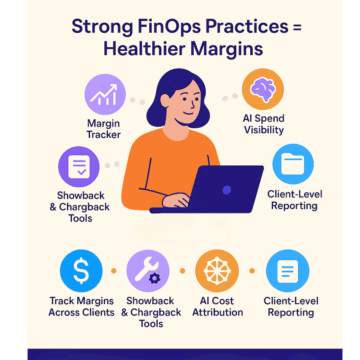
4. Build Transparent and Flexible Billing Models
Billing directly impacts how clients perceive value in their MSP. In a cloud landscape filled with variable usage and complex services, clients expect billing to be clear, flexible, and easy to understand.
Example: A client using multiple cloud providers across departments may need cost breakdowns by business unit, custom markups for premium support, and monthly summaries tailored to their finance team. If your billing model can’t deliver that clarity, your relationship (and renewals) are at risk.
Best practice: Offer usage-based pricing, customizable markups, and detailed re-billing models that fit each client’s structure and expectations.
Umbrella’s advanced re-billing wizard makes this easy by enabling MSPs to:
- Create unique billing rules per client.
- Apply markups by service, environment, or usage tier.
- Automate invoice generation, no more manual spreadsheets or reconciliation headaches.
- Create unique billing rules per client, including tiered pricing and service-specific models.
- Apply markups by service, environment, or usage tier.
- Automate re-billing and reduce reliance on manual spreadsheets or external reconciliation.
- Provide usage and cost breakdowns that can be customized per business unit or cost center.
- Rebill across multi-cloud environments, with support for pooled savings and shared usage allocation.
- Maintain detailed historical cost data for client transparency and financial reporting.
Benefits:
- Fewer billing disputes, since clients can easily trace every charge back to usage data they understand.
- Greater client satisfaction, with flexible billing that aligns with how they operate, whether that’s per team, per region, or product line.
- Improved margin control, as MSPs can track profitability across pricing models and adjust markups as needed to maintain healthy business performance.
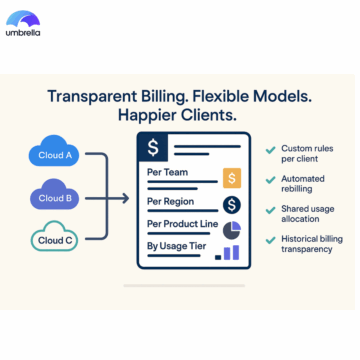
5. Leverage Deep Integration Across Client Environments
Today’s cloud environments are more diverse than ever. MSPs’ clients rely on a mix of AWS, Azure, GCP, Kubernetes, SaaS platforms, and on-premise tools, and they expect their provider to keep it all running smoothly. To deliver consistent performance, accurate cost attribution, and faster troubleshooting, MSPs need tools that integrate deeply across every layer of the tech stack.
Example: A client may utilize AWS for infrastructure, Snowflake for data storage, Datadog for observability, and ServiceNow for support. Without a unified view, an MSP could waste hours stitching together data from different dashboards just to pinpoint the source of a spike in spend or degraded app performance.
Best practice: Select platforms that provide comprehensive integrations across observability, infrastructure, cost, and support systems. Look for compatibility with tools like Datadog, Snowflake, Jira, ServiceNow, and others that your clients rely on.
Umbrella integrates with a wide range of cloud and third-party systems, giving MSPs:
- Centralized visibility across environments.
- Correlated data between usage, performance, and cost.
- Streamlined workflows between support, billing, and FinOps.
Benefits:
- Holistic view of client environments, with unified dashboards that connect usage, cost, and health metrics.
- Faster troubleshooting, as teams can quickly trace issues across interconnected systems without toggling between tools.
- Accurate cost attribution, ensuring every dollar is linked to the right service, team, or environment, essential for FinOps and client trust.
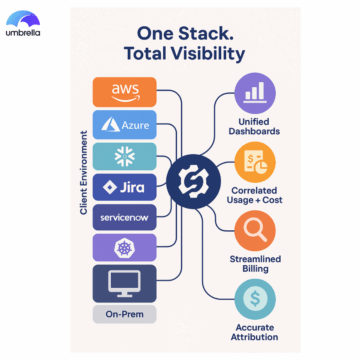
6. Offer Multi-Tenant Visibility with Granular Controls
As MSPs scale, their clients expect more than just reports. They want self-service access to insights, customized for their teams, departments, or business units. However, managing visibility across dozens (or hundreds) of tenants can become messy quickly without the right structure in place.
Example: One enterprise client may want marketing, engineering, and finance teams to each have their own dashboards with tailored views, while restricting access to only their relevant usage and cost data. Meanwhile, another client may require an executive summary that includes high-level KPIs across the entire organization. Supporting both without overcomplicating internal ops is a true test of MSP scalability.
Best practice: Use a platform that supports multi-tenant architecture with granular access controls so each client (and user within that client) sees only what they need.
Umbrella enables MSPs to:
- Build multi-org dashboards that align with client org structures.
- Assign role-based access controls to ensure the right people see the right data.
- Surface cloud unit cost management metrics for individual teams, products, or cost centers.
Benefits:
- Client empowerment is achieved by providing users with real-time visibility into their costs and usage, eliminating the need to file a support ticket.
- Improved internal efficiency, as MSPs spend less time building one-off reports and managing permission errors.
- Increased trust and transparency, helping clients feel more in control of their cloud costs while maintaining a unified, centralized view through their MSP.
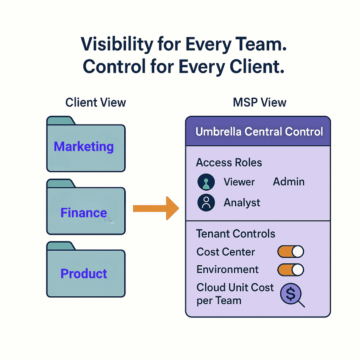
7. Continuously Optimize and Report on ROI
Clients want to see the value their MSP provides, and they want it in clear, measurable terms. That’s why it’s essential to report on the results consistently and transparently.
Example: A client may not notice if you’ve rightsized their infrastructure or reduced idle resources unless you surface those savings. A monthly report showing cost reductions, SLA adherence, and efficiency gains reinforces your value and helps justify renewals or upsells.
Best practice: Establish benchmarks for cost savings, performance improvements, and operational efficiency, and regularly report on them. Make optimization visible and repeatable.
Umbrella’s Savings Tracker helps MSPs:
- Quantify the impact of cost optimization efforts.
- Benchmark and visualize infrastructure improvements.
- Highlight trends over time across usage, performance, and financial metrics.
Benefits:
- Stronger client retention, as regular reporting reinforces value and builds trust.
- Data-driven conversations, enabling MSPs to proactively suggest improvements and strategic changes based on real performance.
- Reduced churn risk, by showing ongoing ROI and making it easier for clients to see the impact of your partnership.
Bonus Best Practices for Growth and Differentiation
While the 7 practices help MSPs deliver efficient and cost-effective service, long-term success also depends on brand positioning, risk management, and market differentiation. These bonus best practices address broader strategies that help MSPs build trust, deepen value, and secure a competitive foothold in a rapidly evolving industry.
Deliver Robust Cybersecurity Services
Cybersecurity is a growing concern that Modern MSPs must proactively address to secure client environments against evolving threats. This tech practice is no longer just a risk-mitigation tactic; it’s a core part of building long-term client trust and delivering consistent value.
It’s something that’s happening right here and now: in July 2025, a ransomware attack on IT distributor Ingram Micro caused distrust among customers and concerns over their handling of sensitive data.
Best practice: Focus on high-impact verticals and service specializations to position your MSP as a strategic partner, prioritizing their clients’ security and data.
Key practices include:
- Adopt a multi-layered security framework: Secure every layer of the stack, from network and endpoints to applications, identity, and cloud environments
| Pro Tip: Clearly document your security policies and frameworks to help meet client and compliance expectations. |
- Enable real-time threat detection and response: Utilize SOC tools, SIEM platforms, and 24/7 monitoring to identify unusual activity and respond promptly before damage is done. Consider the limitations of 9-to-5 and other automotive solutions in providing real-time responses.
| Pro Tip: Put 24/7 monitoring and incident response in place to prevent threats from slipping through during off-hours. |
- Promote zero-trust architecture: Utilize a framework of no one and nothing is trusted by default. Require verification for all users and devices, enforce least-privilege access, and segment networks to limit attacker movement.
| Pro Tip: Enforce zero-trust policies across all clients, not just internally. It’s essential for full-environment protection. |
- Integrate advanced authentication: Deploy passwordless login options and use behavior-based access controls to reduce risk.
| Pro Tip: Don’t roll out advanced authentication all at once. Start with high-risk roles and admin accounts, then expand organization-wide. |
- Automate patching and vulnerability scans: Schedule scans and deploy patches proactively to reduce exposure windows.
| Pro Tip: Create proactive vulnerability management workflows to reduce time-to-remediation and shrink your attack surface. |
- Educate employees: Run security awareness training like a fire drill so when a real threat hits, your team feels prepared for anything.
| Pro Tip: Treat phishing simulations as part of your MSP’s internal playbook. Rotate themes quarterly to reflect real threats and keep training relevant. |
Specialize and Differentiate to Win in a Crowded Market
The MSP landscape is saturated with providers. In a recent report by infrascale, 100% of MSPs said they’re in the thick of high competition. In this environment, growth and longevity depend on the ability to stand out with strategic specialization and differentiated value. How? By aligning deep expertise with the evolving needs of clients in complex industries.
Best practice: Once your vertical is defined, focus on operationalizing it by building packaged offerings tailored to the vertical’s key pain points
With roughly 130,000 managed services providers worldwide, consider these key practices when aiming to stand out in a saturated market.
Key practices include:
- Develop vertical market expertise: Serving industries with regulatory or operational complexity (healthcare, finance, legal, or manufacturing) directly impact people’s lives, so maintain consistency with relevant policies, security frameworks, and operational best practices.
| Pro Tip: Identify and staff clear vertical/sector focus areas across your org. Clients will notice the difference when your expertise matches their language. |
- Create value-added service packages: Build fixed-fee or subscription-based offerings tailored to vertical-specific needs, like Health Insurance Portability and Accountability Act (HIPAA) readiness for healthcare or hybrid cloud services for a distributed team.
| Pro Tip: Actively market these bespoke service packages across your website, proposals, and outbound messaging. |
- Invest in advanced capabilities: Expand into emerging domains such as AI/ML support, IoT management, compliance automation, or advanced analytics to move higher up the value chain.
| Pro Tip: Develop and maintain advanced service domains that align with both your vertical strategy and client demand. |
- Build strategic partnerships: Form alliances with software vendors, cloud providers, and industry organizations to leverage their expertise and resources. Promote relevant certifications and co-marketed solutions to strengthen market credibility.
| Pro Tip: Publicize strategic partnerships and certifications on your site and in client proposals to boost buyer confidence. |
- Continuously train and upskill staff: Implement structured training tracks and encourage role-specific certifications to deepen expertise and support internal growth (In FinOps, this could look like a certification from the FinOps Foundation).
| Pro Tip: Regularly update internal specialization and certification programs to stay ahead of industry shifts and demonstrate credibility. |
Build a Smarter, More Scalable MSP Strategy
From proactive support to automated FinOps, these MSP 7 best practices help providers navigate complexity, deliver consistent service, and strengthen client relationships.
Here’s how:
- Proactive support allows real-time detection of issues before they escalate, reducing downtime and improving client trust.
- Standardized and automated workflows minimize manual errors and create scalable, repeatable service delivery models.
- FinOps practices help MSPs actively manage cloud spend, optimize resource usage, and track profitability across clients.
- Flexible billing models provide clients clarity and customization, while helping MSPs maintain margin control.
- Deep integrations across tools like Datadog, Snowflake, and ServiceNow gives a unified view of cost, performance, and operations.
- Multi-tenant visibility and access controls empower clients to monitor their usage and costs without adding burden to MSP teams.
- Continuous optimization and ROI reporting demonstrate measurable value, reinforce trust, and support long-term client retention.
Umbrella consolidates these capabilities into a single platform. With features like real-time spend anomaly detection, automated savings workflows, role-based access, custom billing rules, and margin tracking, MSPs can scale with confidence and deliver measurable value to every client.
Want to scale smarter? Explore Umbrella’s cloud cost optimization platform for MSPs or book a demo to see how you can simplify complexity and maximize ROI for every client.
